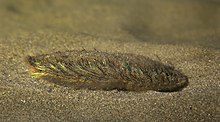Aphrodita aculeata
| Aphrodita aculeata | |
|---|---|

| |
| Scientific classification | |
| Domain: | Eukaryota |
| Kingdom: | Animalia |
| Phylum: | Annelida |
| Clade: | Pleistoannelida |
| Subclass: | Errantia |
| Order: | Phyllodocida |
| Family: | Aphroditidae |
| Genus: | Aphrodita |
| Species: | A. aculeata
|
| Binomial name | |
| Aphrodita aculeata | |

Aphrodita aculeata, the sea mouse, is a marine polychaete worm found in the North Atlantic, the North Sea, the Baltic Sea and the Mediterranean. The sea mouse normally lies buried head-first in the sand. It has been found at depths of over 3,000 metres (9,800 ft).[2]
Etymology
[edit]The name of the genus is taken from Aphrodite, the Ancient Greek goddess of love, said to be because of a supposed resemblance to human female genitalia.[3] The English name may derive from the resemblance to a bedraggled house mouse when washed up on shore.[4] The specific name aculeata is the Latin for spiny.
Description
[edit]The body of the sea mouse is covered in a dense mat of setae (hairlike structures).[5] Adults generally fall within a size range of 10 to 20 centimetres (3.9 to 7.9 in).
Structural coloration
[edit]The spines, or setae,[5] on the scaled back of the sea mouse are one of its unique features. Normally, these have a deep red sheen, warning off predators, but when the light shines on them perpendicularly, they flash green and blue, a "remarkable example of photonic engineering by a living organism". This structural coloration is a defense mechanism, giving a warning signal to potential predators. The effect is produced by many hexagonal cylinders within the spines, which "perform much more efficiently than man-made optical fibres".[6]
Feeding
[edit]The sea mouse is an active predator[2] feeding primarily on small crabs, hermit crabs and other polychaete worms including Pectinaria and Lumbriconereis.[2] It has been observed consuming other polychaete worms over three times its own body length.[2] Feeding activity takes place at night, with the animal partially buried in sand.[2]
References
[edit]- ^ WoRMS: Aphrodita aculeata Linnaeus, 1758
- ^ a b c d e Tyler, Lizzie. "BIOTIC Species Information for Aphrodita aculeata". Biological Traits Information Catalogue. Retrieved 24 December 2014.
- ^ Kennedy, Jennifer (1 October 2019). "Profile of the Sea Mouse Ocean Worm". ThoughtCo. Retrieved 29 September 2021.
- ^ Warren, Rebecca; van Zyl, Miezan; O'Rourke, Ruth; Tokeley, Amber; Heilman, Christine, eds. (2006). "Ocean Life". Ocean: The World's Last Wilderness Revealed (first American ed.). New York City: DK Publishing. p. 276. ISBN 978-0-7566-2205-3.
- ^ a b "sea mouse". Encyclopædia Britannica. Encyclopædia Britannica, Inc. Retrieved April 26, 2012.
- ^ "Sea mouse promises bright future". BBC News. BBC. January 3, 2001. Retrieved April 26, 2012.
